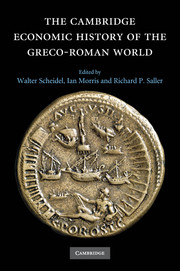Book contents
- Frontmatter
- 1 Introduction
- Part I Determinants of Economic Performance
- 2 Ecology
- 3 Demography
- 4 Household and Gender
- 5 Law and Economic Institutions
- 6 Technology
- Part II Early Mediterranean Economies and the Near East
- Part III Classical Greece
- Part IV The Hellenistic States
- Part V Early Italy and the Roman Republic
- Part VI The Early Roman Empire
- Part VII Regional Development in the Roman Empire
- Part VIII Epilogue
- Bibliography
- Index
- Map 1.1 The Mediterranean basin"
- Map 10.1 Greek and Phoenician trade in the period of the Persian Wars"
- Map 11.1 The Achaemenid empire"
- Map 12.1 Greece and Asia Minor"
- Map 15.1 The Seleucid empire"
- Map 16.1 Greco-Roman Egypt"
- Map 20.1 The Roman empire at the accession of Vespasian"
- References
5 - Law and Economic Institutions
from Part I - Determinants of Economic Performance
Published online by Cambridge University Press: 28 March 2008
- Frontmatter
- 1 Introduction
- Part I Determinants of Economic Performance
- 2 Ecology
- 3 Demography
- 4 Household and Gender
- 5 Law and Economic Institutions
- 6 Technology
- Part II Early Mediterranean Economies and the Near East
- Part III Classical Greece
- Part IV The Hellenistic States
- Part V Early Italy and the Roman Republic
- Part VI The Early Roman Empire
- Part VII Regional Development in the Roman Empire
- Part VIII Epilogue
- Bibliography
- Index
- Map 1.1 The Mediterranean basin"
- Map 10.1 Greek and Phoenician trade in the period of the Persian Wars"
- Map 11.1 The Achaemenid empire"
- Map 12.1 Greece and Asia Minor"
- Map 15.1 The Seleucid empire"
- Map 16.1 Greco-Roman Egypt"
- Map 20.1 The Roman empire at the accession of Vespasian"
- References
Summary
The landscape of the Greek and Roman economies (as of all other economies both past and present) is invariably configured, not just of individuals, but also of institutions, the organized activity of production and commerce. If population and technology established the basic limits within which the economies of the Greek and Roman worlds could develop, it also seems clear that law and other institutions surrounding the economy represented an exogenous factor affecting productivity in the Greek and Roman worlds. An analysis of the complex relationship between legal institutions and the economy can help us to understand better the basic relationships that characterized the economy of the Greco-Roman world. Law and legal institutions helped determine the forms within which economic activity was organized and had important consequences for the basic welfare of people of all classes in the ancient world. Legal institutions shaped the distribution of wealth between the state and citizens or subjects, between city and countryside, between elite landowners and peasant farmers, and even between masters and slaves. It is thus worth examining how these institutions are likely to have influenced economic behavior, allocation of resources, and predictable outcomes in terms of performance and growth. Did legal institutions serve to promote or inhibit the type of investment that was necessary for greater productivity and ultimately for growth in the ancient economy? Did they foster the concentration of wealth in the hands of a small elite, or instead promote a more even distribution of wealth?
Keywords
- Type
- Chapter
- Information
- The Cambridge Economic History of the Greco-Roman World , pp. 113 - 143Publisher: Cambridge University PressPrint publication year: 2007
References
- 37
- Cited by

